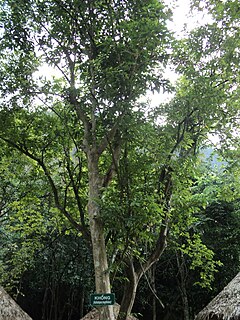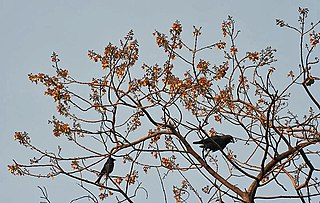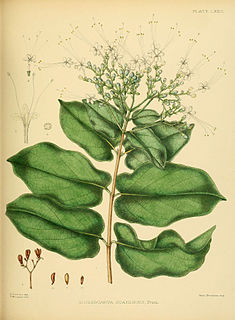
Ajuga, also known as bugleweed, ground pine, carpet bugle, or just bugle, is a genus of 40 species annual and perennial herbaceous flowering plants in the Ajugeae tribe of the mint family Lamiaceae, with most species native to Europe, Asia, and Africa, but also two species in southeastern Australia. They grow to 5–50 cm tall, with opposite leaves.

Agrostistachys is a plant genus of the family Euphorbiaceae first described as a genus in 1850. It is native to Southeast Asia, New Guinea, India, and Sri Lanka.
- Agrostistachys borneensisBecc. - India, Sri Lanka, Thailand, Vietnam, Malaysia, Borneo, Philippines, Sumatra, New Guinea
- Agrostistachys gaudichaudiiMüll.Arg. - Thailand, Peninsular Malaysia
- Agrostistachys hookeri(Thwaites) Benth. & Hook.f. - Sri Lanka
- Agrostistachys indicaDalzell - India, Sri Lanka, Thailand, Vietnam, Myanmar, Laos, Cambodia, Malaysia, Borneo, Philippines, New Guinea
- Agrostistachys sessilifolia(Kurz) Pax & K.Hoffm. - Peninsular Malaysia, Borneo, Sumatra
- Agrostistachys staminodiataSevilla - Sumatra

Koilodepas is a genus of plant of the family Euphorbiaceae first described as a genus in 1856. It is native to Southeast Asia, India, Hainan, and New Guinea.

Endospermum is a genus of plants, under the family Euphorbiaceae and the monotypic subtribe Endosperminae first described as a genus in 1861 It is native to E + S + SE Asia, Papuasia, Queensland, and certain islands of the W Pacific.

Gmelina is a genus of plants in the family Lamiaceae. It consists of about 35 species in Australia, New Guinea, New Caledonia, Southeast Asia, India and a few in Africa. Some species such as G. arborea have been planted and/or become naturalised in India, Africa and Australia. It was named by Carl Linnaeus in honour of botanist Johann Georg Gmelin.

Liparis, commonly known as widelip orchids, sphinx orchids or 羊耳蒜属 is a cosmopolitan genus of more than 350 species of orchids in the family Orchidaceae. Plants in this genus are terrestrial, lithophytic or epiphytic herbs with a wide range of forms. The flowers are usually resupinate and small to medium sized, yellow, yellow-green or purplish with spreading sepals and petals. The labellum is usually larger than the sepals and petals and is lobed, sometimes with a toothed or wavy margin and one or two calli at its base.

Lepidosperma is a genus of flowering plant of the family Cyperaceae. Most of the species are endemic to Australia, with others native to southern China, southeast Asia, New Guinea, New Caledonia and New Zealand.

Gahnia is a genus of sedges native to China, Southeast Asia, New Guinea, Australia, New Zealand and a number of Pacific Islands. The common name is due to the toothed margins. It often forms tussocks.

Rhodomyrtus is a group of shrubs and trees in the family Myrtaceae described as a genus in 1841. The genus is native to southern China, the Indian Subcontinent, Southeast Asia, Melanesia, and Australia.
Polytoca is a genus of Asian and Papuasian plants in the grass family.

Chionachne is a genus of Asian, Australian, and Papuasian plants in the grass family.
Germainia is a genus of Chinese, Asian and Australian plants in the grass family.

Sciaphila is a genus of mycoheterotrophic plants in the family Triuridaceae. These plants receive nutrition from fungi and neighboring trees and have less need for photosynthesis. It is widespread in tropical and subtropical regions, found in Africa, China, Japan, the Indian Subcontinent, Southeast Asia, Latin America and on various islands Pacific Islands.

Adina is a genus of 11 species of flowering plants in the family Rubiaceae. They are shrubs or small trees, native to East Asia and Southeast Asia.

Anisomeles is a genus of herbs of the family Lamiaceae and is native to China, the Indian Subcontinent, Southeast Asia, New Guinea, Australia, Madagascar, and some Pacific and Indian Ocean islands. Plants in the genus Anisomeles have small, flat, narrow elliptic to narrow e.g.-shaped leaves arranged in opposite pairs, the edges of the leaves sometimes wavy or serrated. The flowers are arranged in groups, with five sepals and five petals in two "lips", the lower lip with three lobes, the middle lobe much longer than the side lobes. There are four stamens that extend beyond the petals and a single style in a depression on top of the ovary. The fruit is a schizocarp with four nutlets containing small seeds.

Pollia is a genus of flowering plants in the Commelinaceae, first described in 1781. It is widespread through the Old World Tropics: Africa, southern Asia, northern Australia, etc. There is also one species endemic to Panama.

Glossocarya is a genus of flowering plants in the mint family, Lamiaceae, first described in 1843. It is native to Indochina, Sri Lanka, New Guinea, and Queensland.
- Glossocarya calcicolaDomin - Queensland
- Glossocarya coriaceaMunir - Queensland
- Glossocarya crenataH.R.Fletcher - Thailand
- Glossocarya hemiderma(F.Muell. ex Benth.) Benth. ex B.D.Jacks. - Queensland, New Guinea
- Glossocarya longifloraH.R.Fletcher - Thailand
- Glossocarya mollisWall. ex Griff - Myanmar, Thailand, Vietnam, Paluan Rabana in Malaysia
- Glossocarya premnoidesRidl. - Thailand, Perlis in Malaysia
- Glossocarya puberulaMoldenke - Cambodia
- Glossocarya scandens(L.f.) Trimen - Sri Lanka
- Glossocarya siamensisCraib - Thailand, Vietnam

Platostoma is a genus of flowering plants in the mint family, Lamiaceae, first described as a genus in 1818. It is native to tropical parts of Africa, southern Asia, Papuasia, and Australia. Mesona and Acrocephalus has been known as its synonyms.

Dictyospermum is a genus of monocotyledonous flowering plants in the dayflower family, first described in 1853. It is native to Tropical Asia. They have only three fertile stamens, middle one inserted opposite petal.
Stauranthera is a genus of flowering plants in the family Gesneriaceae, native to Bangladesh, the Nicobar Islands, Assam, the eastern Himalayas, south-central and southeast China, Southeast Asia, and Malesia to New Guinea. It is very close morphologically and genetically to Loxonia.
















